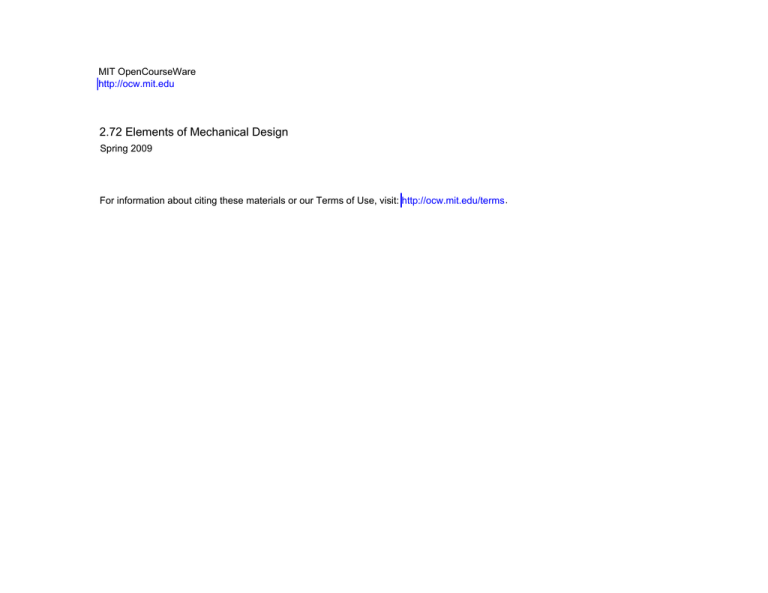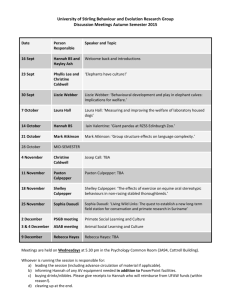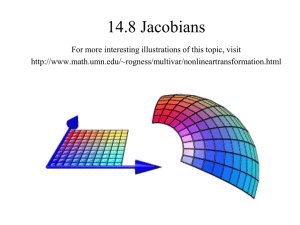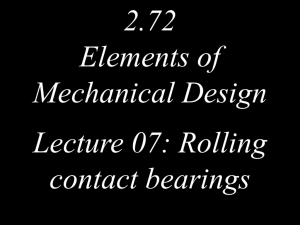
MIT OpenCourseWare
http://ocw.mit.edu
2.72 Elements of Mechanical Design
Spring 2009
For information about citing these materials or our Terms of Use, visit: http://ocw.mit.edu/terms.
2.72
Elements of Mechanical Design
Lecture 05: Structures
Schedule and reading assignment
Quizzes
Quiz – None
Topics
Finish fatigue
Finish HTMs in structures
Reading assignment
None
Quiz next time on HTMs
© Martin Culpepper, All rights reserved
2
Matrix Review
What is a Matrix?
A matrix is an easy way to
represent a system of linear
equations
Linear algebra is the set of
rules that governs matrix
and vector operations
⎡ b1 ⎤
⎢b ⎥
⎣ 2⎦
“Vector”
⎡ a1
⎢a
⎣ 3
a2
⎤
⎥
a4
⎦
“Matrix”
© Martin Culpepper, All rights reserved
4
Matrix Addition/Subtraction
You can only add or subtract matrices of the same dimension
Operations are carried out entry by entry
⎡ a1
⎢a
⎣ 3
a2 ⎤ ⎡ b1
+⎢
⎥
a4 ⎦ ⎣b3
(2 x 2)
⎡ a1
⎢a
⎣
3
b2 ⎤ ⎡ a1 + b1
=⎢
⎥
b4 ⎦ ⎣a3 + b3
(2 x 2)
a2 ⎤ ⎡b1 b2 ⎤ ⎡ a1 − b1
−⎢
=⎢
⎥
⎥
a4 ⎦
⎣
b3 b4 ⎦ ⎣
a3 −
b3
(2 x 2)
© Martin Culpepper, All rights reserved
(2 x 2)
a2 + b2 ⎤
⎥
a4 + b4 ⎦
(2 x 2)
a2 − b2 ⎤
⎥
a4 − b4 ⎦
(2 x 2)
5
Matrix Multiplication
An m x n matrix times an n x p matrix produces an m x p matrix
⎡ a1
⎢a
⎣
3
a2 ⎤ ⎡ b1
⎥
⎢
a4 ⎦
⎣b3
(2 x 2)
b2 ⎤ ⎡ a1b1 + a2b3
=⎢
⎥
b4 ⎦
⎣
a3b1 + a4b3
(2 x 2)
© Martin Culpepper, All rights reserved
a1b2 + a2b4 ⎤
⎥
a3b2 + a4b4 ⎦
(2 x 2)
6
Matrix Properties
Notation: A, B, C = matrix , c = scalar
Cumulative Law:
A+B=B+A
Distributive Law:
c(A + B) = cA + cB
C(A + B) = CA + CB
Associative Law:
A + (B – C) = (A + B) – C
A(BC) = (AB)C
NOTE that AB does not equal BA !!!!!!!
© Martin Culpepper, All rights reserved
7
Matrix Division
To divide in linear algebra we multiply each side by an inverse
matrix:
AB = C
A-1AB = A-1C
B = A-1C
Inverse matrix properties:
A-1A = AA-1 = I (The identity matrix)
(AB)-1 = B-1A-1
© Martin Culpepper, All rights reserved
8
Structures
Machines structures
Structure = backbone = affects everything
Satisfies a multiplicity of needs
Enforcing geometric relationships (position/orientation)
Material flow and access
Reference frame
Requires first consideration and serves to link modules:
Joints (bolted/welded/etc…)
Bearings
Shafts
Parts
Tools
Sensors
Actuators
© Martin Culpepper, All rights reserved
Image removed due to copyright restrictions. Please see
http://www.clarkmachinetools.com/2003_1.jpg
10
Key issues with structural design
Machine concepts
Topology
Material properties
Image removed due to copyright restrictions. Please see
http://www.fortune-cnc.com/uploads/images/1600ge_series.jpg
Principles
Thermomechanical
Elastomechanics
Kinematics
Vibration
Key tools that help
Stick figures
Parametric system/part error model
© Martin Culpepper, All rights reserved
Visualization of the:
Load path
Vibration modes
Thermal growth
11
Modeling: stick figures
Image removed due to copyright restrictions. Please see
http://americanmachinetools.com/images/diagram-lathe.jpg
3
1
2
© Martin Culpepper, All rights reserved
12
Modeling: stick figures
1. Stick figures
These types of models
are idealizations of the
physical behavior. The
designer must KNOW:
2. Beam bending
3. System bend.
(a) if beam bending
assumptions are valid
(b) how to interpret
and use the results o
this type of these
models
3
1
2
© Martin Culpepper, All rights reserved
y
z
x
13
Modeling: stick figures
F
© Martin Culpepper, All rights reserved
14
Transformation Matrices
Translational
Transformation
Matrix
Translational
Transformation
Matrix
Y
P=(A+L
P=(A,
B)1, B+L2)=(A’, B’)
Y’
B
L1
X
A
L2
A’
X’
B’
1
© Martin Culpepper, All rights reserved
=
1
0
L1
A
0
1
L2
B
0
0
1
1
16
Translational Transformation Matrix
General 2D transformation matrix
© Martin Culpepper, All rights reserved
1
0
ΔX
0
1
ΔY
0
0
1
1
0
L1
0
1
L2
0
0
1
17
Rotational
Transformation
Matrix
Rotational
Transformation
Matrix
Y
Y’
P=(A, B)
P=(A’,
B’)
B’
X’
B
Ө
Ө
Ө
X
A’
A
© Martin Culpepper, All rights reserved
18
Rotational
Transformation
Matrix
Rotational
Transformation
Matrix
Y
Y’
P=(A’, B’)
X’
B
Ө
Ө
Ө
X
A
A’ = A cosӨ + B sin Ө
© Martin Culpepper, All rights reserved
19
Rotational Transformation Matrix
Y
Y’
P=(A’, B’)
X’
B
Ө
Ө
Ө
X
A
A’ = A cosӨ + B sin Ө
B’ = -A sinӨ + B cos Ө
© Martin Culpepper, All rights reserved
20
Rotational
Transformation
Matrix
Rotational
Transformation
Matrix
Y
Y’
P=(A’, B’)
B’
X’
B
Ө
Ө
X
A’
cosӨ
sinӨ
0
A
B’ =
-sinӨ
A’ = A cosӨ + B sin Ө
1
0
B’ = -A sinӨ + B cos Ө
cosӨ
0
B
0
1
1
A
© Martin Culpepper, All rights reserved
A’
21
Rotational
Transformation
Matrix
Rotational
Transformation
Matrix
Y
(+Ө) Counter Clockwise
Y’
General 2D rotational
matrix:
X’
Ө
cosӨ
sinӨ
0
-sinӨ
cosӨ
0
0
0
1
Ө
X
Y
Y’
(-Ө) Clockwise
-sinӨ 0
cosӨ
Ө
sinӨsinӨ
cosӨ
cosӨ
0
Ө
X
-sinӨ
0
0
cosӨ
0
0 0
0
1
1
X’
© Martin Culpepper, All rights reserved
22
Homogeneous Transformation Matrix
General 2D HTM translational and rotational matrix:
© Martin Culpepper, All rights reserved
cosӨ
sinӨ
Δx
-sinӨ
cosӨ
Δy
0
0
1
23
HTM Applications
Simple
Beam
Example
Simple
Beam
Example:
B
Y’
A
Y
X’
X
F
L
© Martin Culpepper, All rights reserved
25
Simple
Beam
Example
Simple
Beam
Example:
A
B
Y
X
Y’
Ө
D
F
X’
L
© Martin Culpepper, All rights reserved
26
Useful
Equations
ForceForce-deflection
Deflection Equations
d
d=
F
d
Ө
FL
EA
FL3
d=
3EI
FL2
Ө=
2EI
F
d
Ө
M
© Martin Culpepper, All rights reserved
ML2
d=
2EI
ML
Ө=
EI
27
Simple
Beam
Example
Simple
Beam
Example:
A
B
Y
Y’
X
Ө
D
X’
L
A
B
L
cosӨ
H
B D =
A = sinӨ
1
© Martin Culpepper, All rights reserved
0
-sinӨ L
0
cosӨ
D
0
0
1
1
FL3
D=
3EI
FL2
Ө=
2EI
28
Drill
Press
Example
Simple
Beam
Example:
Find the HTM from a to b:
L
b
c
b
H
a
D
a
F
F
d
L
e
Ha =
b
Cross-Sectional Area of large sections =
Cross-Sectional Area of Drill Bit =
Young’s Modulus of Material =
© Martin Culpepper, All rights reserved
A
1
0
0
0
1
-(D-δ)
0
0
1
Ad
E
29
Useful
Equations
ForceForce-deflection
Deflection Equations
d
d=
F
d
Ө
FL
EA
FL3
d=
3EI
FL2
Ө=
2EI
F
d
Ө
M
© Martin Culpepper, All rights reserved
ML2
d=
2EI
ML
Ө=
EI
30
Drill
Press
Example
Simple
Beam
Example:
Find the HTM from a to b:
L
b
c
b
H
a
D
a
F
F
d
L
e
Ha =
b
Cross-Sectional Area of large sections =
Cross-Sectional Area of Drill Bit =
Young’s Modulus of Material =
© Martin Culpepper, All rights reserved
E
Ad
A
1
0
0
0
1
-(D-δ)
0
0
1
δ=
FD
EAd
31
Drill
Press
Example
Simple
Beam
Example:
Find the HTM from b to c:
L
c
b
H
a
D
c
b
F
F
d
L
e
Cross-Sectional Area of large sections =
Cross-Sectional Area of Drill Bit =
Young’s Modulus of Material =
© Martin Culpepper, All rights reserved
c
Hb =
cosӨ
-sinӨ L
sinӨ
cosӨ
δ
0
0
1
A
Ad
E
32
Useful
Equations
ForceForce-deflection
Deflection Equations
d
d=
F
d
Ө
FL
EA
FL3
d=
3EI
FL2
Ө=
2EI
F
d
Ө
M
© Martin Culpepper, All rights reserved
ML2
d=
2EI
ML
Ө=
EI
33
Drill
Press
Example
Simple
Beam
Example:
Find the HTM from b to c:
L
c
b
H
a
D
c
b
F
F
d
L
e
Cross-Sectional Area of large sections =
Cross-Sectional Area of Drill Bit =
Young’s Modulus of Material =
© Martin Culpepper, All rights reserved
E
Ad
c
Hb =
cosӨ
-sinӨ L
sinӨ
cosӨ
δ
0
0
1
A
FL3
δ=
3EI
FL2
Ө=
2EI
34
Drill
Press
Example
Simple
Beam
Example:
Find the HTM from c to d:
L
c
c
b
H
a
F
FL
D
F
d
L
e
Cross-Sectional Area of large sections =
Cross-Sectional Area of Drill Bit =
Young’s Modulus of Material =
© Martin Culpepper, All rights reserved
Ad
A
d
Hc =
d
cosӨ
-sinӨ
-δ1
sinӨ
cosӨ
H+δ2
0
0
1
E
35
Useful
Equations
ForceForce-deflection
Deflection Equations
d
d=
F
d
Ө
FL
EA
FL3
d=
3EI
FL2
Ө=
2EI
F
d
Ө
M
© Martin Culpepper, All rights reserved
ML2
d=
2EI
ML
Ө=
EI
36
Drill
Press
Example
Simple
Beam
Example:
Find the HTM from c to d:
L
c
c
b
H
a
F
FL
D
F
d
L
e
Cross-Sectional Area of large sections =
Cross-Sectional Area of Drill Bit =
Young’s Modulus of Material =
© Martin Culpepper, All rights reserved
E
A
d
Hc =
d
Ad
FLH
Ө=
EI
cosӨ
-sinӨ
-δ1
sinӨ
cosӨ
H+δ2
0
0
1
FLH2
δ1 =
2EI
FH
δ2 =
EA
37
Drill
Press
Example
Simple
Beam
Example:
Find the HTM from d to e:
L
c
b
H
a
D
d
F
FL
F
d
L
e
Hd =
e
Cross-Sectional Area of large sections =
Cross-Sectional Area of Drill Bit =
Young’s Modulus of Material =
© Martin Culpepper, All rights reserved
e
Ad
A
1
0
-L
0
1
0
0
0
1
E
38
Drill
Press
Example
Simple
Beam
Example:
Find the HTM from a to e:
L
c
H
a
F
d
L
H a = e Hd d Hc c Hb b Ha
e
b
D
Find the vector aVe from e to a:
0
e
aV
Cross-Sectional Area of large sections =
Cross-Sectional Area of Drill Bit =
Young’s Modulus of Material =
© Martin Culpepper, All rights reserved
A
e
=
Ha
e
0
1
Ad
E
39
Method
building
system’s HTM
Simplefor
Beam
Example:
• Identify key nodes around the system’s
structural loop
• Create HTMs for each member between each
node
• Multiply the member’s HTMs in the correct
order
© Martin Culpepper, All rights reserved
40
More on HTMs
3D HTMs
For x-axis
rotation
For y-axis
rotation
For z-axis
rotation
0
⎡1
⎢0 cos θ
x
⎢
⎢0 − sin θ x
⎢
0
⎣0
⎡cos θ y
⎢ 0
⎢
⎢ sin θ y
⎢
⎣ 0
⎡ cos θ z
⎢− sin θ
z
⎢
⎢ 0
⎢
⎣ 0
© Martin Culpepper, All rights reserved
0
sin θ x
cos θ x
0
0 − sin θ y
1
0
0
0
cos θ y
0
sin θ z
cos θ z
0
0
X
⎤
Y ⎥⎥
Z
⎥
⎥
1⎦
X⎤
Y ⎥⎥
Z⎥
⎥
1⎦
For small Ө:
cos(Ө)~1 & sin(Ө)~ Ө
0 X⎤
0 Y ⎥⎥
1 Z⎥
⎥
0 1⎦
42
HTM Rotation
•Remember order of multiplication matters:
180
deg
flip
90
deg
right
90
deg
right
180
deg
flip
•To combine a translation and rotation, again multiply the HTM matrices
together
•Note that the order of the rotation and translation matrices does matter, so
makes sure the answer makes sense!!!
© Martin Culpepper, All rights reserved
43







